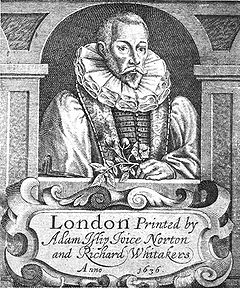John Gerard
| John Gerard | |
|---|---|

John Gerard
Frontispiece of 1636 edition of Herball |
|
| Born | 1545 Nantwich, Cheshire, England |
| Died | 1612 (aged 66–67) London, England |
| Resting place | St Andrews, Holborn |
| Residence | Holborn, London |
| Citizenship | British |
| Fields | Botany |
| Known for | The book Herball, or Generall Historie of Plantes |
| Author abbrev. (botany) | J.Gerard |
John Gerard, also spelt John Gerarde, (c. 1545–1612) was a botanist and herbalist. He maintained a large herbal garden in London. His chief notability is as the author of a large (1,484 pages) illustrated Herball, or Generall Historie of Plantes. First published in 1597, it was the most widely circulated botany book in English in the 17th century. Except for the additions of a number of plants from his own garden and from North America, Gerard's Herbal is largely an unacknowledged English translation of Rembert Dodoens's herbal originally published in 1554, itself also highly popular (in Dutch, Latin, French and other English translations).
Gerard's Herball is profusely illustrated with high-quality drawings of plants, with the printer's woodcuts for the drawings largely coming from Continental European sources, but also containing an original title page with copperplate engraving by William Rogers.
Two decades after Gerard's death, his Herball was corrected and expanded to about 1700 pages. The botanical genus Gerardia is named in Gerard's honour.
Gerard was born at Nantwich, Cheshire, towards the end of 1545, receiving his early and only schooling at nearby Willaston, about two miles away. Nothing is known of his parentage, but the coat of arms on his Herball implies he was a member of the Gerards of Ince. Around the age of 17, in 1562 he became an Apprentice to Alexander Mason (d. 3 April 1574), a barber-surgeon of the Barber-Surgeon's Company (Company of Barbers and Surgeons), in London. Mason had a large surgical practice and had twice held the rank of Warden in the company, and later became Master. Gerard did well there, and after seven years was admitted to the freedom of the company (Freeman) on 9 December 1569 and permitted to open his own practice. Although he claimed to have learned much about plants from travelling to other parts of the world (see for instance his letter to Lord Burghley in 1588), his actual travels appear to have been limited. For example, at some time in his later youth, he is said to have made one trip abroad, possibly as a ship’s surgeon on a merchant ship sailing around the North Sea and Baltic, for he refers to both Scandinavia and Russia in his writings.
...
Wikipedia
